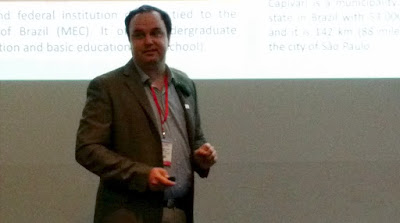Translate
Monday, August 7, 2017
ICV 27 - Speaker 5: Christopher Maddish
The title of the paper was Colour Coding and New Vexillological Avenues for Flag Design. The framework for colour coding flags to numbers was presented. Examples were given several areas including: longitude and latitude, altitude, chemistry, and even postal zones. In the second part of the lecture other un-flagged areas were presented: geographic birthright flags, maritime flags areas without a flag, and many more.
ICV 27 Speaker 4: Kevin Harrington
Kevin Harrington's paper was entitled Flags and the Anniversaries of 2017: Myths, Mistakes, Misconceptions. Harrington spoke briefly about flags that were changed due to the Socialist Red Scare, namely of the old red Oklahoma flag and a few others. Harrington also gave an enchanting retelling of his youthful excitement in 1965 when the current Canadian flag was adopted, which he instantly loved.
Harrington proposed that the some Canadian flags with the red and blue ensign may have never existed, and only came into existence due to assumptions and errors. Essentially the Admiralty was making mistakes and assumptions, based upon the hypotheticals. As of yet there is no direct evidence that some flags existed. Perhaps the flags were proposed, but none were created to fly on a flag pole?
Much of flag history comes about though the official publications of government issued Naval Communications and Flag Authority books. In this case, the Admiralty of the UK were responsible for organizing, cataloging and charting proper use of flags for use at sea. They were never intended to be a target of vexillological or academic use, but they have become trustworthy sources for researching flags.
ICV 27 - Speaker 3: Ted Kaye
Ted Kaye gave an overview on the current state of flag redesign with bad flags across the nation in his paper American City Flag Redesign: a Welcome Change. Ted discussed the current spur to get new flags based upon the recent Ted Talks program by popular Internet voice Roman Mars.
Kaye attributes much momentum to change 'Bad Flags' to one particular pod cast, which you can below on YouTube or visit the site directly with the link. It was due to 'shaming' efforts of Roman Mars that Potacello, Idaho was able to get a flag redesign for a 'Good Flag.'
Ted Kaye also analyzed why flags get stalled in the flag changing process. Many times flag changing event are stalled due to internal politics, resentment of current political situations, and the old attachment to the original flag.
https://www.ted.com/talks/roman_mars_why_city_flags_may_be_the_worst_designed_thing_you_ve_never_noticed
ICV 27 - Speaker 2: Tiago Jose Berg
Tiago Jose Berg spoke about Vexillology with High School Students. Since Brazil was the recent host to the International Olympic games in 2016, much of the nation was swept by that magical wand of international connections. Berg spoke about a flag making project amongst his student body.
The high school students in Brazil were charged with recreating by hand, with paints the flags of the world. This project slowly took over the school and the completed flags were exhibited all across the school. Due to the quality craftsmanship of the students, their flag art was exhibited further out at universities across Brazil.
Olympics or not is always a great way to teach history by having the students create well crafted flags; as students make the flags, they are often encouraged to understand why and how the colours are used.
ICV 27 - Speaker 1: Annie Platoff
Little Leninists: flags, symbols, and the political socialization of Soviet Children was the title of Platoff's presentation. In the United States we have the cub scouts, boy and girl scouts, but during the Cold War the Soviet Union had parallel organizations like the Little Octoberists and the Young Pioneers. These often patriotic organizations are just one aspect of 'civil religions' in academia, whereby positive moral values are emphasized and patriotism for the state is encouraged.
 |
| Annie Platoff in 'US Civil Religion Outfit' Left - 1978 |
A curated selection of emblems and symbols for Soviet Era children were shown and discussed. Platoff also emphasized that she dose not encourage nor promote the political values of the Soviet Union, but rather finds the culture of Russia to be a point of personal and professional interest. In addition Platoff is nearly fluent in Russian and has extensively traveled across Eurasia.
 The theme of the three races was also prominent of Soviet Era multiculturalism: that of the generic Sub-Saharan African, Far East Asian, and White European. Coincidentally today the theme of the three races can be found in a similar manner in American Media parallel to Soviet Era and modern day times.
The theme of the three races was also prominent of Soviet Era multiculturalism: that of the generic Sub-Saharan African, Far East Asian, and White European. Coincidentally today the theme of the three races can be found in a similar manner in American Media parallel to Soviet Era and modern day times. Platoff closed that nations should also explore their own 'Civil Religions'. Essentially a key component of many Civil Religions are youth programs that teach about one's nation and political history, in addition to giving them task oriented survival skills.
Tuesday, July 25, 2017
Don't Tread On Me, Cobra Kai
Cobra Kai is the fictional Dojo in the Karate Kid that trains the bullies. Their motto is "Strike First, Strike Hard, No Mercy." Although Cobra's don't have rattles, they do have hoods, that tell their opponent to back off or else.
Subscribe to:
Posts (Atom)



